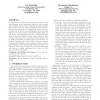32 search results - page 3 / 7 » User-centric content freshness metrics for search engines |
PAMI
2012
11 years 8 months ago
2012
—Web-scale image search engines (e.g. Google Image Search, Bing Image Search) mostly rely on surrounding text features. It is difficult for them to interpret users’ search int...
WWW
2009
ACM
14 years 6 months ago
2009
ACM
Comprehensive coverage of the public web is crucial to web search engines. Search engines use crawlers to retrieve pages and then discover new ones by extracting the pages' o...
ITNG
2006
IEEE
14 years 1 days ago
2006
IEEE
Purpose – This paper reports the findings of a major study examining the overlap among results retrieved by three major web search engines. The goal of the research was to: mea...
WSDM
2010
ACM
14 years 3 months ago
2010
ACM
Social media sites (e.g., Flickr, YouTube, and Facebook) are a popular distribution outlet for users looking to share their experiences and interests on the Web. These sites host ...
WEBI
2007
Springer
14 years 4 days ago
2007
Springer
Search engines largely rely on robots (i.e., crawlers or spiders) to collect information from the Web. Such crawling activities can be regulated from the server side by deploying ...

